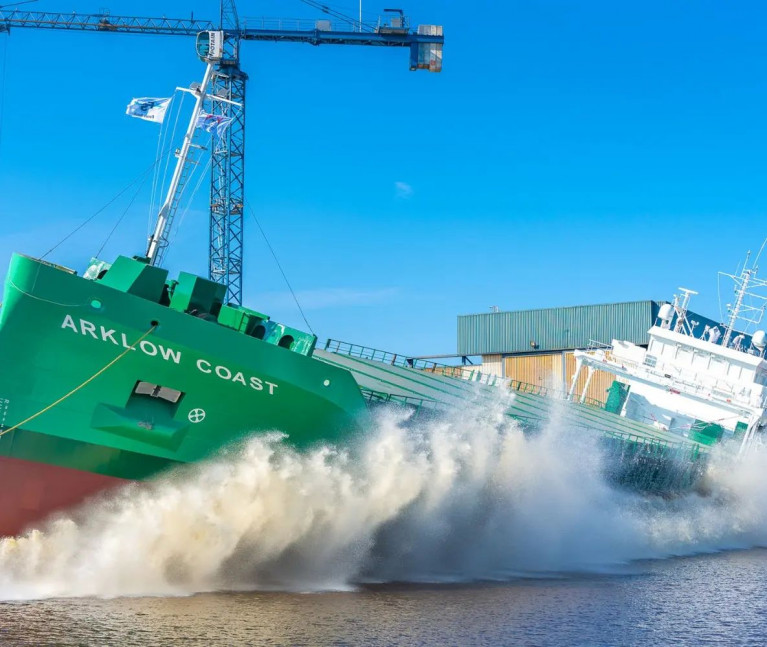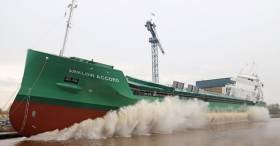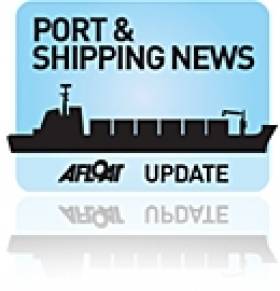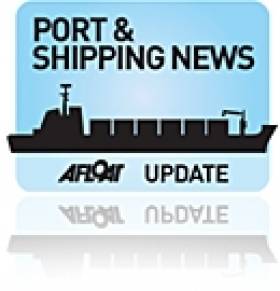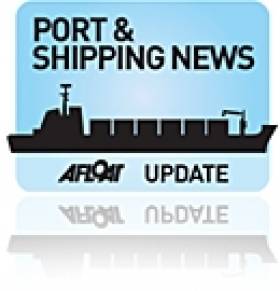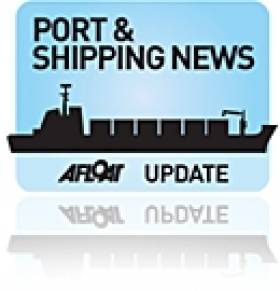Displaying items by tag: ASL
Final Newbuild of 10 Ship-Series Launched for Arklow Shipping's 'C' Class Cargoships
The launch of Arklow Crest has culminated in the final newbuild of a ten-ship series for Irish shipowners, when the short sea trader took to the waters at a Dutch shipyard last Friday, writes Jehan Ashmore.
With a newbuild number of 436, Arklow Crest slid into the canal at Ferus Smit's shipyard in Westerbroek which was contracted to build the new design cargo vessels for Arklow Shipping.
The Co. Wicklow shipowners having received the leadship of the series, Arklow Cadet which took place in 2016. During this year the shipyard completed a trio of the 'C' class general cargoships with Arklow's Cloud, Coast and Cove and all currently in service.
All but one of the 10 'C' class were given ship names never previously used by vessels of the ASL fleet which was formed in 1966.
Following sea trials and delivery to ASL the Arklow Crest will be able to provide clients a maximized hold volume of 220.000 cft and a carrying capacity over 5,000 deadweight tons. This makes the almost 88m long vessel still fall under the 3,000 gross tons limit.
The single hold cargoship has an 1A iceclass notation and for propulsion, this is generated from a 1,740kW MaK engine and using a single ducted propeller.
A typical bread and butter cargo will be in the carriage of grain.
Likewise of the C class series, Arklow Crest is registered at its east coast homeport and will represent the newest merchant ship of the Irish-flagged fleet.
Newbuild Short-Sea 'Coaster' Brings to Eight Out of Ten C-Class Cargoships for Arklow Shipping
Once again the newest C-class series of short-sea traders for Arklow Shipping, launched in a shipyard in The Netherlands, has been given a ship name first for the Co. Wicklow based shipowner, writes Jehan Ashmore.
On this occasion, Saturday's launch of the 5,054dwat newbuild saw the Arklow Coast take to the waters of the Winschoterdiep canal at Ferus Smit's shipyard at Westerbroek.
The new 87m cargoship will further modernise ASL's almost 60-strong Irish-Dutch flagged fleet, that includes deep sea ocean going bulkers, the largest been a pair of S-class, each of 34,905dwat. In addition to the dwindling R-class of 4,933dwat. Among them the oldest, Arklow Rainbow which Afloat observed depart Dublin Port last week when bound to Northfleet, London.
As for the new Irish-flagged C-Class cargoships, they are given names beginning with the letter 'C'. Such newly created names having differred to previous generations of tonnage dating back to the 1980's. An exception to the nomenclature has been Arklow Castle (see 'European' trader) which follows two predecessors taking this same name.
The previous 'Castle' built for ASL and dating to 1996, was notably a 'containership' which is a rarity for ASL operations, having served a 'liner' service linking the UK, Ireland and Spain. This lo-lo link was discontinued following ASL's disposal of the 532TEU capacity containership.
Whereas, the original Arklow Castle built in 1981 was secondhand tonnage for ASL, until its career ended dramatically when it became wrecked more than a decade later at Sables d'Olonne on the west coast of France.
As for the current Arklow Coast, which represents the 8th of 10 C-class cargoships ordered by ASL and follows Arklow Cloud which Afloat reported late last year also launched at Westerbroek.
A maximized single hold equates to a volume of 220,000 cft and a carrying capacity over 5000 deadweight tons. The newbuild has been given a 1A ice class notation and is propelled by a 1,740 kW MaK engine with a single ducted propeller.
The straight-stemmed bow is equipped with a 275kW electric bowthruster to assist operations in port. Related to that Afloat today tracked several of the C-class cargoships located to ports in north-west Europe, the Baltic Sea and trading in the western Mediterranean.
A New Accord Brings Further Expansion of Arklow Shipping Fleet
Arklow Accord is the latest of a new series for ship-owner Arklow Shipping Ltd, however the bulk oriented cargo vessel is also a first for the company to use this ship name, writes Jehan Ashmore.
The launching of newbuild Arklow Accord (Nb. 438) which took place on Friday, represents the second of a six ships using the Arklow 'A' naming scheme. The order by ASL is with shipbuilder Ferus Smit at their Dutch shipyard located in Westerbroek.
Currently the company have almost 60 vessels including Dutch division Arklow Shipping Nederland B.V. and this milestone is to be exceeded with the roll-out of the Arklow A - series.
The design of Arklow Accord will see its operations chiefly employed in the shipment of corn, wheat and other bulk commodities in European waters.
The inland yard at Westerbroek, is where Irish flagged leadship Arklow Abbey was also given the customary launched sideways in July and with the newbuild entering service two months later.
According to Ferus Smit, the design is a slightly modified version of the first series of 8600dwt bulkers that the shipyard built under the Arklow B – series. The new design is adapted for iceclass 1A, with modified bow form and propulsion with a propeller nozzle added.
At the same time, the main engine output was decreased to 2000 kW for better fuel efficiency.
Listed below are the basic characteristics of Arklow Accord:
– Loa = 119.495 mtr
– Lpp = 116.895 mtr
– B = 14.99 mtr
– D = 9.70 mtr
– T max = 7.160 mtr
– Hold volume = 350.000 cft
The delivery of the Arklow registered newbuild is due for January 2020.
Arklow Clan Yet to Christen Fourth Launched Newbuild 'C' Class
#DoubleEvents - On the same day ICG’s new Irish Ferries cruiseferry had a first steel-plate cutting ceremony held in a German yard, this was in marked contrast to Arklow Shipping having yet another ship launched in neighbouring Netherlands, writes Jehan Ashmore.
Arklow Clan (yard No. 427) an open-hatch decker was launched successfully on Friday at Ferus Smit’s yard in Westerbroek. The newbuild is the fourth 5,200dwt general cargoship built so far in a series of 10 that began with the ‘Cadet’ last year.
Likewise of interim sisters, Arklow Cape and Arklow Castle (see report), the latest newbuild was launched into the waterway with the public having an opportunity to view from the opposite side along the ‘Winschoterdiep’. The launching however was performed without ceremony, as the christening of Arklow Clan is to take place at a later stage.
Last year marked the 50th year of Arklow Shipping Limited following an amalgamation in 1966 of three independent shipowning families. The Tyrrell, Kearon and Hall families all had origins directly in trading auxiliary sailing schooners from the banks of the River Avoca that flows through the Co. Wicklow port.
Arklow Clan is a short-sea trader built from a new design or of the ‘C’ Class series that will each have a maximized hold volume of 220.000 cft and a carrying capacity over 5000 deadweight tons. These characteristics will make this newbuild and sisters still fall under the 3,000 gross tons limit.
The single-hold vessel will be given an 1A iceclass notation and propelled by a 1740 kW MaK engine with a single ducted propeller.
Delivery of Arklow Clan is scheduled for May, the same month in 2018 that was originally announced by ICG/Irish Ferries newbuild for delivery. As reported today, the giant 50,000grt cruiseferry, however will be delivered by FSG Flensburg later in mid-2018.
Returning to Ferus-Smit’s Dutch yard which has been contracted also by ASL for a quartet of small handy-sized bulk-carriers. They will be around 16,500dwt each and with the first pair to be delivered next year.
Newbuilds Expand Arklow Shipping Fleet
#NEWBUILDS-Two of the latest newbuilds for Arklow Shipping, one built in Spain and the second ship comleted from a South Korean shipyard, both entered service late last year and raises the fleet total to 44 vessels.
The northern Spanish built Arklow Forest became the 10th 'F' class vessel which was launched from Astilleros de Murueta SA. She is a 2,998grt vessel with a single-box hold with two portable bulkheads which can be placed into 10 positions for cargo separation. Her main engine plant is a MAN 6L27/38 2040kW gearbox with CPP, delivering about 12 knots.
Also entering service in late 2011 the Arklow Moor a 13,975dwt newbuild which formed the fifth in the series of 'M'-class vessels and she was built in South Korea by the Mokpo Shipyard Corporation. The class have four holds with a total grain capacity of 18,110 m3. They are fitted with a MaK 6M 43C main engine, 5,400kW, Jake reduction gearbox and Rolls Royce CPP which delivers about 14 knots.
Both newbuilds are registered in their owner's homeport and are Irish flagged. Of the 44-strong fleet, the majority of vessels (34) are managed by Arklow Shipping and the balance of vessels (11) are run by Arklow Shipping N.V.
Arklow Shipping Expands Fleet into Handysize Bulker Market
#PORTS & SHIPPING – Arklow Shipping is further expanding its bulker fleet and moving into the market for larger vessels with an order for three ships in South Korea, according to Tradewinds.
The company which is headquartered in the Co. Wicklow port has booked two 35,000-dwt handysize-bulkers and a general cargoship at Daesun Shipbuilding. TradeWinds sources say Arklow is paying a premium for the ships against more competitive pricing from China.
Brokers price the Daesun bulkers at around $25.5m, which compares to similar deals in China at around $22m. As for the general cargoship, she will be delivered in the first half of 2013 and the bulkers in the second half of the year. Arklow previously signed up for a series of 14,000-dwt multipurpose (MPP) vessels at Mokpo, which later went into administration.
The orders were then passed on to Sekwang Shipbuilding only for it also to fall into financial difficulties. Daesun has had its problems too and was delisted from the Seoul Stock Exchange in April as it did not meet the bourse's financial requirements.
The latest order appears to have taken Arklow's owned fleet into the larger-handysize segment. So far it has focussed mainly on bulkers, general-cargo and MPP ships up to 14,000 dwt. It has a fleet of 55 ships including 12 newbuildings, most of which are registered in the Republic of Ireland. Arklow declines to comment on the Daesun order.
New Arklow Bulker Docks In Dublin to Load at Tara Mines Facility
She has a gross tonnage of 2,998 and a single-box hold with two portable bulkheads which can be placed into 10 positions for cargo separation. At 4,800 dwt, ship is certified for the carriage of dangerous goods of IMO Class 4.1, 4.2, 4.3, 5.1 and 5.2 (packaged) as well as general bulk cargoes. The main engine is a MAN 6L27/38 2040kW gearbox with CPP, delivering about 12 knots.
The 89m Arklow Forest was one of the 4,500 dwt 'R' class designs but was modified to allow carriage of a further 300 tonnes of cargo. She follows Arklow Field (PHOTO) which entered service this year and to read a report on another F class, Arklow Future click HERE.
Arklow Shipping Ltd with its headquarters in Co. Wicklow operate the fleet which in the majority are Irish registered. Some vessels though are managed through Dutch subsidiary Arklow Shipping Netherland B.V. based in Rotterdam where they are also registered in that port.
New €1.5m Rail-Spur for Dublin Port
The minister welcomed "the important investment by Dublin Port Company in its rail network. It will further enhance the attractiveness of the port as a destination for rail-based freight. The project represents a commitment on the part of Dublin Port Company and Iarnród Éireann to customers who want to move goods by rail".
The project took six months to complete and the public private partnership involved Dublin Port Company, Iarnród Éireann and the first customer of the new facility, International Warehousing and Transport (IWT).
IWT is a privately owned Irish logistics company, which already operates freight-trains to Ballina that are expected to increase from 4 to 5 trains per week in each direction as a result of this investment. The rail-operator believes that the service will save up to 5.5million road kilometres annually and reduce CO2 emissions by up to 2,750 tonnes.
The Irish Exporters Association also welcomed the development of the IWT freight operation at the new facility, where increased frequency in services will enhance Ireland's contribution to the European Union's modal shift aspirations from road to rail.
The Common User Terminal is also open to other shipping companies. Existing clients using the lo-lo container terminal operated by Burke Shipping Group through its subsidiary Portroe Stevedores are C2C Lines, APL, Coastal Containers, Evergreen, Gracechurch and OOCL . The terminal also has a ro-ro berth facility where CLdN /Cobelfret operate from on routes to Belgium and The Netherlands.
In addition to the Dublin-Ballina service the port exports 400,000 tonnes of lead and zinc concentrate from the freight customers Boliden/Tara Mines with 15 trains per week. The facility at Alexandra Basin Jetty is regularly served by vessels from Arklow Shipping Ltd, where the 2011 newbuild Arklow Field (2,998 tonnes) is currently berthed.
- Dublin Port
- Dublin Port Company
- Arklow Shipping Ltd
- Irish Exporters Association
- Port of Dublin
- Ports and Shipping News
- IEA
- Minister for Transport
- Ocean Pier
- Irish Rail
- Iarnrod Eireann
- Portroe Stevedores
- Dublin Port news
- IWT
- ASL
- Leo Varadkar T.D.
- Port of Dublin news
- Railfreight
- International Warehousing and Transport
- Alexandra Basin East
- Common User Terminal
- Burke Shipping Group
- Clnd Cobelfret
- Boliden
- Tara Mines
- Arklow Field
- Dublin Shipping
- Lead mines
- Zinc mines
- Irish Railways
- Dublin Port railhead
Cargoship Gets into Scrap in Wicklow
The cargoship Arklow Rebel (2,999 gross tonnes) which loaded scrap metal in Wicklow Port today, is believed to be the largest Arklow Shipping Ltd vessel to dock in the east coast port, writes Jehan Ashmore.
The 7-year old Dutch-built vessel arrived in ballast from Warrenpoint Co. Down around 01.30hrs to berth alongside the town's south quays at the Packet Quay.
Throughout this afternoon there was a steady stream of lorries laden with the scrap-metal which was loaded into the ship's hull by a quayside grabber. Upon completion of loading, the distinctive green hulled Arklow Rebel departed this evening bound for Liverpool.
She is one of nine 'R'class series of ships built by the Dutch shipyard of Barkmeijer Stroobos B.V. and has the following dimensions (90m length X 12m breath X 4m draft). For further vessel characteristics click HERE.
The Irish-flagged vessel is registered at the neighbouring port of Arklow to the south and is part of a fleet of over 40 ships managed by the Tyrrell family.
During the boom years Wicklow port was particularly busy with Scandinavian imports of bundled packaged timber and plasterboard for the construction industry.
The tidal port at the mouth of the River Leitrim also specialises in paper, lead, steel and dry bulk cargoes, principally coal in addition to other general and heavy-lift project cargoes.
For many years the issue of road traffic congestion was finally solved when the Wicklow Port Access and Town Relief Road Scheme was completed in April of last year.
The port access road (1.6km) runs between the Rathnew Road to The Murrough via a bridge that crosses the Broadlough Estuary and over the Dublin-Rosslare railway line.
- Wicklow
- Arklow Shipping Ltd
- Wicklow harbour
- Liverpool
- ASL
- Wicklow Port
- Port of Wicklow
- Wicklow Port Access and Town Relief Scheme
- Arklow Rebel
- Tyrrell
- ScrapMetal
- Port and Shipping News
- Packet Quay Wicklow
- Wicklow Port Company
- Broadlough Estuary
- River Leitrim
- The Murrough
- DublinRosslare railway line
- Barkmeijer Stoobos B.V.
Arklow's Asian Newbuilds
Arklow Shipping (ASL) has turned to the Sekwang Shipbuilding, South Korea for three general cargoships according to www.tradewinds.no
An order has been placed for three 14,200-dwt general cargoships at the yard for delivery from late 2012 to early 2013. The deal includes an option for an extra vessel. To read more click here.
Separate to the Asian newbuild programme is the 4,700 gross tonnes Arklow Bridge (click photo) the latest vessel completed for Arklow Shipping B.V. from the Dutch shipyard of Bodewes B.V.
The Co.Wicklow based company was established in 1966 and has a current fleet of over 40 vessels under the Irish, Dutch and Antiguan flags.


























